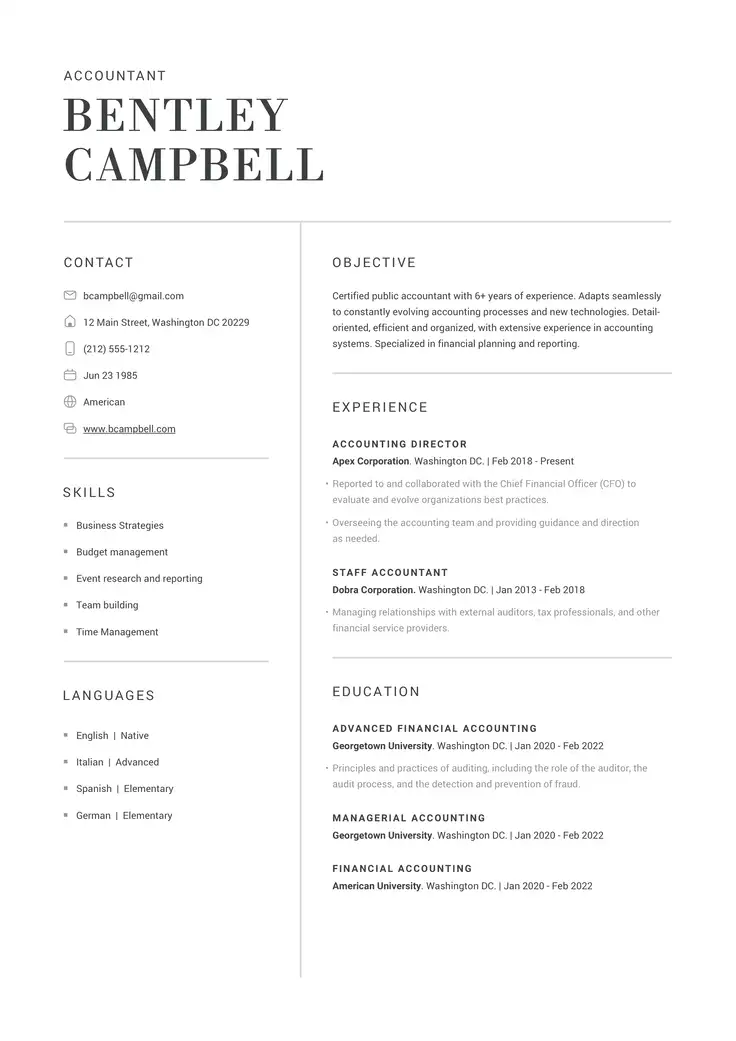Like many professionals, you may be considering “what’s next” on your career ladder, even after moving up in the company ladder.
But how exactly do you list promotions on your resume?
In this article, we will walk you through the process and considerations for showing promotions on your resume.
Whether you’re applying for an internal promotion or hoping to secure a leadership role, you’ll walk away understanding:
- How to list promotions on a resume
- How to correctly format your promotion on a resume
- Whether you should mention the promotion in a separate section
- How to articulate the difference between the roles (we’ll show you with some resume examples)
You can then use our AI resume builder to help you incorporate your promotion into your different resume sections with ease.
Should I List a Promotion on My Resume?
Absolutely! Your current and future employers want to see your growth and impact within a single company. Job promotions are a great way to show that you’ve become an expert, gone above and beyond, and mastered your role. Employers want professionals who will come in, take ownership of their role and job responsibilities, learn quickly, and thrive. Promotions are an indicator that you have those traits and abilities.
When it comes to looking for a new role, try shedding the belief that showcasing your accomplishments is “showing off” or being “too confident.” Remember, no one will know how incredible you are if you don’t tell them! Your resume is the place to do this.
Let’s go ahead and get into the details of how to list promotions on your resume.
Expert Advice on Adding Promotions to Your Resume
-
💡 Our expert’s advice

As a Nationally Certified Resume Writer (NCRW), I’ve spent years experimenting with what works and what doesn’t work when it comes to listing promotions. I’ve met with recruiters and hiring managers to learn their preferences as well. Based on my conversations and jobseeker’s outcomes, I can confidently tell you that the best and easiest way to list promotions on a resume is by showcasing the different positions you’ve held (with exceptions) within the company.
Your goal is to showcase your achievements, career advancement, and impact. It can be challenging to stuff it all into one role. Listing promotions as separate roles will allow you to highlight your biggest accomplishments under each title you’ve held.
For the sake of ease, let’s use a Marketing Professional as an example.
Separate listings for each role – example
Having separate entries is beneficial if you’ve held multiple roles within the same company, as it is a clean and easy-to-read format for showing your job progression. This method is also effective in showing how your day-to-day duties have significantly changed on your upward trajectory.
Experience
Company Name, City, State
Senior Marketing Manager (Month/Year – Present)
Led the development and implementation of marketing strategies for product launches while overseeing a team of 10 marketing professionals. Conducted market analysis to identify new business opportunities.
- Increased sales 40% through targeted marketing campaigns.
- Boosted customer engagement by 30% via social media initiatives.
- Improved team productivity by 15% through process optimization.
Marketing Manager (Month/Year – Month/Year)
Coordinated marketing campaigns across various channels, including digital and print. Managed relationships with key stakeholders to ensure marketing alignment. Developed content for promotional materials and advertisements.
- Enhanced brand awareness by 25% through innovative campaigns.
- Achieved a 10% increase in lead generation year-over-year.
- Reduced marketing costs by 12% through vendor negotiations.
Assistant Marketing Manager (Month/Year – Month/Year)
Supported the marketing team in the execution of campaigns. Conducted market research to identify potential trends and opportunities. Partnered with graphics team in the creation of marketing materials and presentations.
- Contributed to a 15% increase in customer retention through targeted campaigns.
- Streamlined research processes, reducing time spent by 20%.
- Played a key role in a campaign that generated 500 new leads.
This is the best way to format a promotion resume. Keep in mind if your goal is to secure a leadership role within or outside of your company, you want to make sure to use the right keywords throughout your resume. Check out our article on Leadership Skills for Your Resume.
How To List Different Promotions Under One Role
In special cases, it may be challenging to show multiple roles from your career history. For example, if you’ve been promoted more than five times and you have additional relevant work experience outside of your company, you may consider combining promotions under one role. This will help you avoid a 3-to-4-page resume.
In addition, if your job duties and achievements across your promotions were similar, you might choose to combine them under a single listing. This approach to showing your career trajectory is also streamlined and avoids redundancy.
Combining promotions under one role – example
Again, we’ll take the role of a Marketing Manager to demonstrate this type of resume format.
Experience
Company Name, City, State
Marketing Manager (Month/Year – Present)
Promoted from Assistant Marketing Manager to Senior Marketing Manager within three years due to exemplary performance and commitment to driving excellence. Led a team of 10 professionals in developing and executing marketing strategies. Coordinated with sales and product teams to ensure marketing alignment. Conducted market research and analysis to guide marketing efforts.
- Increased sales by 40% through effective marketing strategies.
- Boosted customer engagement by 30% via social media initiatives.
- Improved team productivity by 15% through process optimization.
- Enhanced brand awareness by 25% through innovative campaigns.
- Achieved a 10% increase in lead generation year-over-year.
- Reduced marketing costs by 12% through vendor negotiations.
This option provides you with the opportunity to save space and quickly showcase your promotion to a senior position to hiring managers and recruiters. If this ends up being your chosen format, make sure to choose the impressive achievements that will position you for the industry and position you want.
How To Show Promotions on a Resume Within the Same Role
What is a promotion within the same role? Sometimes, these are referred to as “lateral promotions” or “in-role advancements.”
They don’t often come with an increase in responsibilities without the formal title change. Even without the title, they still reflect significant professional growth. In case you’re wondering, “Yes! These are definitely worth listing on your resume.”
Why? Even if your job title didn’t change, an internal promotion indicates that your employer recognized your increasing value and contribution to the organization. Highlighting these advancements on your resume shows potential employers that you have a track record of growth and that you consistently took on more responsibilities, showcasing your ability to adapt, learn, and excel.
Promotions within the same role – example
Let’s see how this lateral promotion or in-role advancement can be clearly demonstrated on your resume.
Experience
Company Name, City, State
Marketing Manager (Month/Year – Present)
Initially hired as an Assistant Marketing Manager and promoted to Senior Marketing Manager. Expanded responsibilities to include overseeing product launches and leading a larger team. Developed and implemented comprehensive marketing strategies. Conducted market analysis and monitored industry trends.
- Successfully increased sales by 40%.
- Led a team that boosted customer engagement by 30%.
- Improved team productivity by 15% through process optimization.
- Enhanced brand awareness by 25% through innovative campaigns.
As you are writing your resume and listing promotions, remember that your goal is always to show continuous growth. Make it easy for the reader to follow your career journey.
As you review your description and achievements in your work experience section, make sure that you clearly explain what additional responsibilities you took on and how your role expanded compared to your previous position. This can include information on the following:
- The increase of employees you manage.
- A bigger budget.
- Overseeing more programs.
- Collaborating with more leaders and stakeholders.
- How your expertise has expanded (did you gain any new certifications or software competencies?)
Where to Show Promotions Throughout Your Resume
-
💡 Our expert says

Another question I often hear is, “Can I mention my promotion in other sections?” The answer is, of course you can! As mentioned earlier, being promoted is a big deal, and you should share it as often as you can.
While the work experience section is the primary place to detail your career progression and promotions, incorporating mentions of your promotions in other sections of your resume can quickly grab the Hiring Manager’s attention and reinforce your best qualities! Below are two sections in which you can list your promotion:
Promotions in your resume summary
The summary section is your first impression. Think of it as your elevator pitch that sets the tone for the rest of your resume. You want to immediately hook the reader by showcasing how your impact and influence have been recognized and rewarded throughout your career.
Summary
Innovative and data-driven Marketing Professional with 8+ years experience in increasing sales, brand awareness, and customer engagement. Promoted from Assistant Marketing Manager to Senior Marketing Manager within three years, driving a 20% increase in sales through innovative strategies and effective team leadership.
Mentioning it right in your resume summary can show a hiring manager right away that you have grown in your role. With our AI summary generator, you can naturally fit your career progression in without showing off.
Achievement section
Another potential area to list your promotion is your achievement section. If you don’t mention your promotion in your summary, we recommend following up your summary with your top 3 career achievements. Check out the sample below:
Summary
Innovative and data-driven Marketing Professional with 8+ years experience in increasing sales, brand awareness, and customer engagement. Committed to driving excellence through fostering creative, collaborative, and forward-thinking team cultures.
Top Career Highlights:
- Promoted from Assistant Marketing Manager to Senior Marketing Manager within three years, driving a 20% increase in sales through innovative strategies and effective team leadership.
- Led a team that boosted customer engagement by 30%.
- Improved team productivity by 15% through process optimization.
Do you see how this section allows you to show off your career growth, share your professional journey, and position yourself as the best person for the job? This is exactly what a compelling resume consists of. With this competitive job market, it’s crucial that you utilize all the best practices when it comes to writing your resume.
Hopefully, you’re feeling confident about how to list promotions on your resume! Now, it’s time to move on to formatting. After all, your achievements need to be easy to read, look great, and articulate your value. Here are a few formatting tips to boost your chances of landing your next promotion!
Formatting and Wording Tips for Listing Your Promotions
Showcasing promotions on your resume involves more than just listing job titles and dates. It’s about clearly communicating your career progression and the value you added in each role. Here are the top five resume format and wording tips to help you present your promotions in the best light.
1. Use clear and consistent formatting
Consistency in formatting ensures that your resume is easy to read and professional. This means that you use the same structure for dates, job titles, the name of the company, job description, and location across all sections of your resume.
2. Highlight achievements with bullet points
You want your achievements to stand out and be noticeable. Bulleted lists are an effective way to highlight your key achievements, new skills gained, and responsibilities in each role. This format makes your resume easy to scan and emphasizes the most important information for the reader for both your current position and previous roles.
3. Use strong action verbs
Be mindful of the words you use. Using strong action verbs helps to convey your accomplishments and levels of responsibility from distinct roles with more impact. Action verbs like “led,” “developed,” “implemented,” and “oversaw” demonstrate initiative and leadership.
4. Quantify your achievements
Show off your impressive accomplishments. Quantifying your achievements with specific metrics provides concrete evidence of your contributions and impact on meeting or surpassing your KPIs. Use numbers, percentages, and other metrics whenever you can to highlight the scope and success of your work.
5. Detail evolving responsibilities and promotions
Clearly detail the evolution of your responsibilities and the context of your promotions. Highlight the new tasks and projects you took on with each step up the career ladder, emphasizing how your role expanded throughout your job promotions.
FAQs
Yes, you should list your promotions when they help demonstrate career growth and your best results. Promotions show employers that you’ve been trusted to take on more complex tasks and deliver positive outcomes.
Make sure each promotion adds value to your story by highlighting achievements by including new responsibilities and your results.
Avoid listing promotions if they clutter your resume or don’t add meaningful value to the role you want.
For example, if multiple promotions occurred in a short time but involved similar duties, consider grouping them under one job entry.
Also leave them out if they shift focus away from more relevant experience.
Yes, promotions look excellent on a resume, especially if you’re looking for a job in the same field. They’re a strong indicator of reliability, strong performance, and professional growth.
Listing promotions also helps differentiate you from candidates with similar experience by demonstrating advancement, initiative, and long-term value within an organization.
Related Blogs


